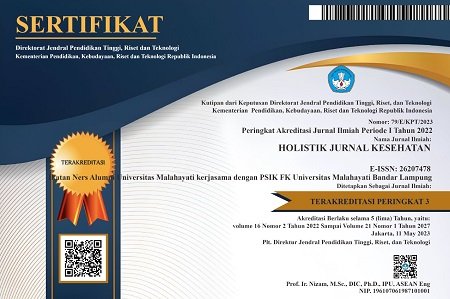Return of spontaneous circulation (ROSC) dengan menggunakan resusitasi jantung paru (RJP) mekanik dan manual: A literature review
Abstract
Background: Cardiac arrest is a condition where a person's heartbeat stops suddenly due to damage to the heart's electrical system so that the heart cannot circulate blood throughout the body. If this is not treated immediately it can cause more severe brain damage. Of the 58 million people in the world, 31% of deaths are caused by heart disease. It is estimated that around 17.8 million deaths each year are caused by cardiovascular disease and of the total deaths in 1 year around 31% worldwide.
Purpose: To provide an overview of the results of a literature review regarding the effectiveness of using mechanical compression and manual compression in cardiac arrest patients.
Method: This research uses a literature review method, namely a method of selecting literature from various sources and then analyzing the literature to obtain a conclusion. The journals taken in conducting this literature review are journals that discuss topics with four types of keywords, namely effectiveness, manual resuscitation, mechanical resuscitation, and return of spontaneous circulation (ROSC).
Results: Based on searches and reviews of 10 journals, it was found that mechanical compression was more effective than manual. Mechanical compression has not only been proven to help ROSC in cardiac arrest patients but the use of mechanical devices does not cause higher traumatic injuries when compared with manual compression.
Conclusion: Mechanical devices do not cause a higher rate of traumatic injury when compared with manual compression.
Keywords: Effectiveness; Manual Resuscitation; Mechanical Resuscitation; Return of Spontaneous Circulation (ROSC).
Pendahuluan: Keadaan henti jantung (cardiac arrest) merupakan keadaan terhentinya detak jantung yang secara tiba-tiba terjadi pada seseorang disebabkan oleh kerusakan sistem kelistrikan jantung sehingga jantung tidak dapat memberikan aliran darah ke seluruh tubuh. Bila hal ini tidak segera ditangani maka dapat menyebabkan kerusakan otak yang lebih parah. Sebanyak 58 juta jiwa yang ada di dunia, 31% angka kematian disebabkan oleh penyakit jantung. Diperkirakan sekitar 17.8 juta kematian setiap tahunnya disebabkan dari penyakit kardiovaskuler dan dari total kematian dalam 1 tahun sekitar 31% di seluruh dunia.
Tujuan: Untuk memberikan gambaran hasil literature review tentang keefektifan penggunaan kompresi mekanik dan kompresi manual pada pasien henti jantung.
Metode: Penelitian ini menggunakan metode literature review yaitu suatu metode memilih literatur dari berbagai sumber kemudian menganalisis literatur tersebut sehingga diperoleh sebuah kesimpulan. Jurnal yang diambil dalam pelaksanaan literature review ini adalah jurnal yang membahas mengenai topik dengan empat jenis kata kunci yaitu, efektivitas, resusitasi manual, resusitasi mekanis, dan return of spontaneous circulation (ROSC).
Hasil: Berdasarkan penelusuran dan review 10 jurnal didapatkan kompresi mekanik lebih efektif dibandingkan dengan manual. Kompresi mekanik tidak hanya terbukti membantu ROSC pada pasien henti jantung namun penggunaan perangkat mekanis tidak menyebabkan cedera traumatis lebih tinggi bila dibandingkan dengan kompresi manual.
Simpulan: Perangkat mekanis tidak menyebabkan cedera traumatis lebih tinggi bila dibandingkan dengan kompresi manual.
Kata kunci : Efektivitas; Resusitasi Manual; Resusitasi Mekanis; Return of Spontaneous Circulation (ROSC).
Keywords
References
Couper, K., Quinn, T., Booth, K., Lall, R., Devrell, A., Orriss, B., ... & Perkins, G. D. (2021). Mechanical versus manual chest compressions in the treatment of in-hospital cardiac arrest patients in a non-shockable rhythm: A multi-centre feasibility randomised controlled trial (COMPRESS-RCT). Resuscitation, 158, 228-235.
Cristy, N. A., Ryalino, C., Suranadi, I. W., & Hartawan, I. G. A. G. U. (2022). Angka keberhasilan resusitasi jantung paru pada pasien yang mengalami henti jantung di Rumah Sakit Umum Pusat Sanglah. Jurnal Medika Udayana, 11(4), 50-54.
Darwati, L. E., Winarni, I., & Haedar, A. (2015). Studi fenomenologi: pengalaman perawat dalam melaksanakan asuhan keperawatan pada pasien henti jantung di salah satu igd rumah sakit tipe a di jawa timur. Medika Respati: Jurnal Ilmiah Kesehatan, 10(4).
Fauzi, A., & Pratama, E. F. (2023). Perbandingan Efektivitas Rjp Mekanik dan Manualterhadap Kejadian Return of Spontaneous Circulation (Rosc) Pada Pasien Henti Jantung. Jurnal Antara Keperawatan, 6(1), 1-10.
Ganthikumar, K. (2016). Indikasi dan keterampilan resusitasi jantung paru (RJP). Intisari Sains Medis, 6(1), 58-64.
Gao, M., Niu, H., & Yuan, S. (2022). Comparison between automated cardiopulmonary resuscitation and manual cardiopulmonary resuscitation in the rescue of cardiac and respiratory arrest. Pakistan journal of medical sciences, 38(8), 2208.
Kementerian Kesehatan Republik Indonesia. (2022). Penyakit Jantung Penyebab Utama Kematian, Kemenkes Perkuat Layanan Primer. Kementerian Kesehatan Republik Indonesia. Diakses dari: https://sehatnegeriku.kemkes.go.id/baca/rilis-media/20220929/0541166/penyakit-jantung-penyebab-utama-kematian-kemenkes-perkuat-layanan-primer/
Kim, W., Ahn, C., Kim, I. Y., Choi, H. Y., Kim, J. G., Kim, J., & Shin, D. G. (2022). Prognostic Impact of In-Hospital Use of Mechanical Cardiopulmonary Resuscitation Devices Compared with Manual Cardiopulmonary Resuscitation: A Nationwide Population-Based Observational Study in South Korea. Medicina, 58(3), 353.
Mastenbrook, J., Redinger, K. E., Vos, D., & Dickson, C. (2022). Retrospective Comparison of Prehospital Sustained Return of Spontaneous Circulation (ROSC) Rates Within a Single Basic Life Support Jurisdiction Using Manual vs Lund University Cardiac Assist System (LUCAS-2) Mechanical Cardiopulmonary Resuscitation. Cureus, 14(6).
Mulyadi, N., & Katuuk, M. E. (2017). Pengaruh simulasi tindakan resusitasi jantung paru (rjp) terhadap tingkat motivasi siswa menolong korban henti jantung di sma negeri 9 binsus manado. Jurnal Keperawatan, 5(1).
Mulyana, D. S. (2013). Analisis penyebab insiden keselamatan pasien oleh perawat di unit rawat inap rumah sakit X Jakarta. Universitas Indonesia, 3.
Sagala, N. S., Napitupulu, N. F., Siregar, H. R., Harahap, E. M., Sujoko, E., & Dalimunthe, K. A. Y. (2023). Penyuluhan Kesehatan Tentang Bantuan Hidup Dasar/Resusitasi Jantung Paru Di Asrama Putri Universitas Aufa Royhan. Jurnal Pengabdian Masyarakat Aufa (JPMA), 5(2), 7-11.
Saleem, S., Sonkin, R., Sagy, I., Strugo, R., Jaffe, E., Drescher, M., & Shiber, S. (2022). Traumatic Injuries Following Mechanical versus Manual Chest Compression. Open Access Emergency Medicine, 557-562.
Şan, I., Bekgöz, B., Ergin, M., & Usul, E. (2021). Manual cardiopulmonary resuscitation versus mechanical cardiopulmonary resuscitation: Which one is more effective during ambulance transport?. Turkish Journal of Emergency Medicine, 21(2), 69.
Savitri, N. P. A. (2018). Pengaruh Pelatihan Bantuan Hidup Dasar Pada Sekaa Truna Truni Terhadap Keterampilan Memberikan Pertolongan Pada Keluarga Dengan Kasus Henti Jantung Di Banjar Tengah Desa Gulingan, Mengwi, Badung (Doctoral dissertation, Jurusan keperawatan 2018).
Şener, A., Günaydın, G. P., & Tanrıverdi, F. (2021). Mechanical versus manual chest compression: a retrospective-cohort in out-of-hospital cardiac arrest. Acta Medica, 52(4), 325-331.
Suratinah, S. (2022). Efektivitas RJP Mekanik dengan Manual terhadap Kejadian Return of Spontaneous Circulation (ROSC) pada Pasien Henti Jantung di IGD RSUD Pasar Minggu: The Effectiveness of Manual Mechanical CPR on Return of Spontaneous Circulation (ROSC) Incidence in Cardiac Arrest Patients in the ER Pasar Minggu Hospital. Open Access Jakarta Journal of Health Sciences, 1(10), 327-333.
Tantarattanapong, S., & Chantaramanee, K. (2022). Comparison of Sustained Return of Spontaneous Circulation Rate Between Manual and Mechanical Chest Compression in Adult Cardiac Arrest. Open Access Emergency Medicine, 599-608.
Wiryowidagdo, S. (2016). Tanaman Obat untuk Penyakit Jantung, Darah Tinggi, dan Kolesterol. AgroMedia.
World Health Organization. (2021). Cardiovascular Diseases. World Health Organization. Diakses dari: https://www.who.int/health-topics/cardiovascular-diseases/.
DOI: https://doi.org/10.33024/hjk.v17i9.13060
Refbacks
- There are currently no refbacks.
Copyright (c) 2024 Holistik Jurnal Kesehatan

This work is licensed under a Creative Commons Attribution-NonCommercial 4.0 International License.














